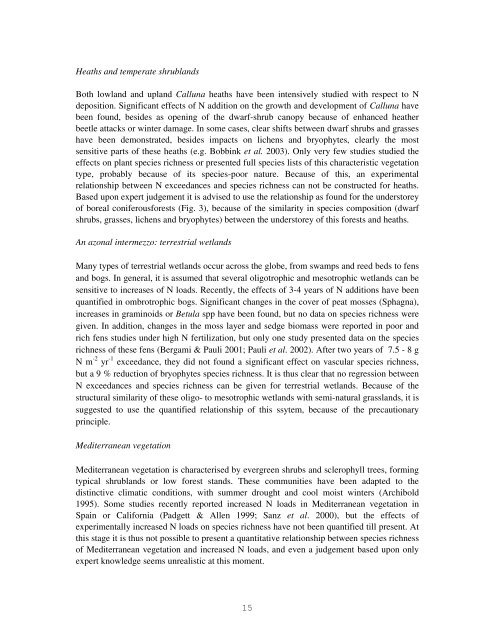plant species richness and the exceedance of ... - ResearchGate
plant species richness and the exceedance of ... - ResearchGate
plant species richness and the exceedance of ... - ResearchGate
Create successful ePaper yourself
Turn your PDF publications into a flip-book with our unique Google optimized e-Paper software.
Heaths <strong>and</strong> temperate shrubl<strong>and</strong>s<br />
Both lowl<strong>and</strong> <strong>and</strong> upl<strong>and</strong> Calluna heaths have been intensively studied with respect to N<br />
deposition. Significant effects <strong>of</strong> N addition on <strong>the</strong> growth <strong>and</strong> development <strong>of</strong> Calluna have<br />
been found, besides as opening <strong>of</strong> <strong>the</strong> dwarf-shrub canopy because <strong>of</strong> enhanced hea<strong>the</strong>r<br />
beetle attacks or winter damage. In some cases, clear shifts between dwarf shrubs <strong>and</strong> grasses<br />
have been demonstrated, besides impacts on lichens <strong>and</strong> bryophytes, clearly <strong>the</strong> most<br />
sensitive parts <strong>of</strong> <strong>the</strong>se heaths (e.g. Bobbink et al. 2003). Only very few studies studied <strong>the</strong><br />
effects on <strong>plant</strong> <strong>species</strong> <strong>richness</strong> or presented full <strong>species</strong> lists <strong>of</strong> this characteristic vegetation<br />
type, probably because <strong>of</strong> its <strong>species</strong>-poor nature. Because <strong>of</strong> this, an experimental<br />
relationship between N <strong>exceedance</strong>s <strong>and</strong> <strong>species</strong> <strong>richness</strong> can not be constructed for heaths.<br />
Based upon expert judgement it is advised to use <strong>the</strong> relationship as found for <strong>the</strong> understorey<br />
<strong>of</strong> boreal coniferousforests (Fig. 3), because <strong>of</strong> <strong>the</strong> similarity in <strong>species</strong> composition (dwarf<br />
shrubs, grasses, lichens <strong>and</strong> bryophytes) between <strong>the</strong> understorey <strong>of</strong> this forests <strong>and</strong> heaths.<br />
An azonal intermezzo: terrestrial wetl<strong>and</strong>s<br />
Many types <strong>of</strong> terrestrial wetl<strong>and</strong>s occur across <strong>the</strong> globe, from swamps <strong>and</strong> reed beds to fens<br />
<strong>and</strong> bogs. In general, it is assumed that several oligotrophic <strong>and</strong> mesotrophic wetl<strong>and</strong>s can be<br />
sensitive to increases <strong>of</strong> N loads. Recently, <strong>the</strong> effects <strong>of</strong> 3-4 years <strong>of</strong> N additions have been<br />
quantified in ombrotrophic bogs. Significant changes in <strong>the</strong> cover <strong>of</strong> peat mosses (Sphagna),<br />
increases in graminoids or Betula spp have been found, but no data on <strong>species</strong> <strong>richness</strong> were<br />
given. In addition, changes in <strong>the</strong> moss layer <strong>and</strong> sedge biomass were reported in poor <strong>and</strong><br />
rich fens studies under high N fertilization, but only one study presented data on <strong>the</strong> <strong>species</strong><br />
<strong>richness</strong> <strong>of</strong> <strong>the</strong>se fens (Bergami & Pauli 2001; Pauli et al. 2002). After two years <strong>of</strong> 7.5 - 8 g<br />
N m -2 yr -1 <strong>exceedance</strong>, <strong>the</strong>y did not found a significant effect on vascular <strong>species</strong> <strong>richness</strong>,<br />
but a 9 % reduction <strong>of</strong> bryophytes <strong>species</strong> <strong>richness</strong>. It is thus clear that no regression between<br />
N <strong>exceedance</strong>s <strong>and</strong> <strong>species</strong> <strong>richness</strong> can be given for terrestrial wetl<strong>and</strong>s. Because <strong>of</strong> <strong>the</strong><br />
structural similarity <strong>of</strong> <strong>the</strong>se oligo- to mesotrophic wetl<strong>and</strong>s with semi-natural grassl<strong>and</strong>s, it is<br />
suggested to use <strong>the</strong> quantified relationship <strong>of</strong> this ssytem, because <strong>of</strong> <strong>the</strong> precautionary<br />
principle.<br />
Mediterranean vegetation<br />
Mediterranean vegetation is characterised by evergreen shrubs <strong>and</strong> sclerophyll trees, forming<br />
typical shrubl<strong>and</strong>s or low forest st<strong>and</strong>s. These communities have been adapted to <strong>the</strong><br />
distinctive climatic conditions, with summer drought <strong>and</strong> cool moist winters (Archibold<br />
1995). Some studies recently reported increased N loads in Mediterranean vegetation in<br />
Spain or California (Padgett & Allen 1999; Sanz et al. 2000), but <strong>the</strong> effects <strong>of</strong><br />
experimentally increased N loads on <strong>species</strong> <strong>richness</strong> have not been quantified till present. At<br />
this stage it is thus not possible to present a quantitative relationship between <strong>species</strong> <strong>richness</strong><br />
<strong>of</strong> Mediterranean vegetation <strong>and</strong> increased N loads, <strong>and</strong> even a judgement based upon only<br />
expert knowledge seems unrealistic at this moment.<br />
15


